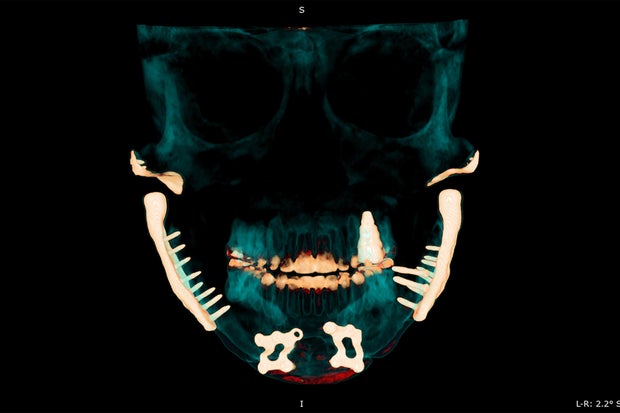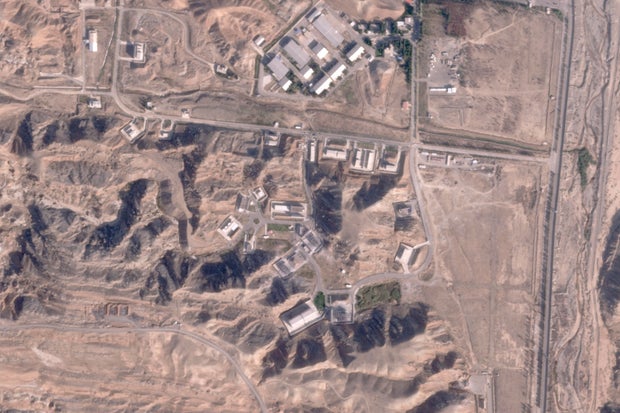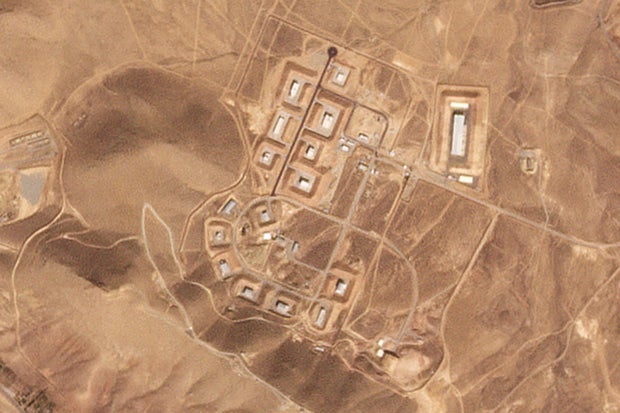CBS News
How TMJ’s out-of-pocket costs drive patients into “a bottomless pit” of debt

Over three decades of relentless pain, Jonna Tallant has tried about every TMJ treatment: mouthguards, six sets of braces, dental crowns and appliances, drugs, physical therapy, Botox, massage, acupuncture, chiropractic care and surgery.
Nothing has helped. Tallant, 51, of Knoxville, Tennessee, said she lives in agony and cannot eat any food that must be chewed. Despite spending a small fortune on treatment, she can barely open her mouth enough to squeeze in a toothbrush.
Tallant estimates she has paid at least $200,000 for TMJ care. She provided medical records showing more than $60,000 in out-of-pocket spending in just the past decade. She has exhausted her savings and borrowed money, she said, and her family sold a plot of land to help pay the bills.
Tallant will need another jaw surgery later this year, which could cost as much as $75,000. Her insurance is unlikely to pay for any of it, she said.
“It’s a bottomless pit,” Tallant said, choking up, as she leafed through a pile of medical records splayed on her dining table. “It has consumed so much of my life that there is not much left.”
Brett Kelman/KFF Health News
Temporomandibular joint disorders, known as TMJ or TMD, cause pain and stiffness in the face and jaw and are believed to afflict as many as 33 million Americans. Scientific studies have found that women experience TMJ disorders two to nine times as often as men, and while minor symptoms may not require treatment, severe symptoms can include disabling pain that makes it challenging to eat, work, talk or sleep.
Despite the commonness of TMJ disorders, treatments are often not covered by medical or dental insurance, leaving patients with out-of-pocket bills that can range from a few hundred dollars to tens of thousands of dollars. Many medical insurers consider TMJ treatment too dental-focused for medical insurance, while dental insurers consider it too medical for dental insurance, leaving patients stuck in a “medical-dental divide” that hinders care and increases cost, according to the National Academies of Science, Engineering, and Medicine.
Worse still, researchers warn that the meager insurance coverage available for TMJ often excludes the safest forms of care while steering patients toward surgery — a riskier and irreversible option that the National Institutes of Health recommends “staying away” from.
Medical scan provided by Lisa Schmidt; image created by Brett Kelman/KFF Health News
Terrie Cowley, a longtime TMJ patient who leads the TMJ Association, an advocacy group, has spoken with patients who refinanced their homes and cashed out retirement accounts to afford the out-of-pocket costs for their care.
“It bankrupts them,” Cowley said. “But it isn’t nearly as horrible as when the treatments go wrong.”
Insurance woes are just one facet of the problems with TMJ care in the United States. In April, a joint investigation by KFF Health News and CBS News found that TMJ disorders have been widely misunderstood by many dentists for decades, so some patients fall into a spiral of ineffective care and futile surgeries that do more harm than good. Dentistry has tried to correct course in recent years with the promising new specialty of orofacial pain, which treats TMJ disorders with a more conservative approach, but these specialists are few and rarely covered by insurance, so their services remain beyond the reach of many patients.
Tony Schwartz, president of the American Board of Orofacial Pain, said the specialty is still fighting for widespread acceptance from insurance companies and some dentists, who cling to “old, debunked theories” that TMJ disorders are caused by misaligned teeth or a bad bite.
“This is the basis for why insurance companies have been so reluctant to, over the years, pay for any treatment,” Schwartz said. “Because there has been so much controversy about what works and what doesn’t work.”
For this article, KFF Health News and CBS News interviewed 10 patients with severe TMJ disorders who have been in treatment for years, if not decades. Almost all the patients described spending thousands of dollars out-of-pocket at every stage of their care, usually because treatment fell outside their medical and dental insurance coverage. Some patients said their medical bills mounted just as debilitating pain forced them to leave jobs or abandon careers. Some underwent expensive TMJ surgeries offered by only a small group of surgeons who generally do not accept insurance.
Kyra Wiedenkeller, 45, of New York state, said she worked as a manager in the music industry, including on “American Idol,” before her “unrelenting pain” became too great.
Wiedenkeller, who is now on disability, said she’s spent at least $100,000 out-of-pocket on TMJ treatment and provided medical documents showing she had been billed for at least that much.
Anna Werner/CBS News
“Every doctor I’ve seen has made me progressively worse,” said Wiedenkeller. “I paid an exorbitant amount of money. I wiped out my 401(k) for these treatments in hopes of getting better time and time again. And just get worse and worse. I feel like there is no end.”
Wiedenkeller’s story echoes findings of the national academies, which conducted a comprehensive study of TMJ in 2020 that included input from more than 110 patients. The study found that TMJ patients are “often harmed” during “overly aggressive” treatment, which frequently falls into a chasm between medical and dental insurance, leaving most bills paid out-of-pocket at costs of up to tens of thousands of dollars.
As an example, the study describes how dental splints — a common TMJ treatment — have been considered to be medical care by some dental insurers and considered dental care by some medical insurance programs, and are “therefore not covered” by either.
And when TMJ is covered by insurance, it tends to exclude “low-risk, effective treatments,” like those used by orofacial pain specialists, but covers “higher-risk” options, like jaw surgery, according to the national academies study. This leads to patients receiving “the care that is best reimbursed, rather than the care that is best,” the study said.
Other researchers have come to the same conclusion.
James Fricton, an orofacial pain specialist who studies the lack of insurance coverage for TMJ care, said that even though surgery is appropriate for few patients, it is the only treatment covered by most insurance plans in most states.
“Patients will assume that insurance companies know what they’re doing,” Fricton said. “If that’s all that’s covered, what do you think they are going to get? Surgery.”
In contrast, insurance coverage appears to be weakest at the other end of the treatment spectrum.
“Orofacial pain,” officially recognized by the American Dental Association in 2020, is now taught in residency programs at at least a dozen U.S. colleges, including the universities of Michigan, Minnesota and North Carolina. The specialty avoids making irreversible changes to the bite or jaw and instead treats TMJ disorders with tools like counseling, dietary changes, medication, physical therapy and removable dental splints. Many TMJ patients can be treated by orofacial pain specialists for a few thousand dollars.
The national academies study describes this approach as one of the few promising options for TMJ patients, citing studies that showed improvement among patients who are taught how to manage their pain. But the national academies also said it is a “particular challenge” that this treatment is “often not considered reimbursable by insurance.”
In separate interviews, six orofacial pain specialists with clinics across the country said insurance coverage for this specialty care is patchy, poor, or nonexistent. Several said their specialty is often absent from dropdown menus on standard insurance forms. Most said the insurance industry had fallen behind on the evolving science of TMJ, missing a chance to help patients and cut costs.
“It’s a no-brainer,” said Jeffrey Okeson, dean of the University of Kentucky’s College of Dentistry. “If I was an insurance person, I’d want to supply $1,000 to a patient to do conservative treatment … instead of $15,000 or $30,000 for surgery. Think of the money that can be saved there.”
Okeson and the other orofacial pain specialists said unreliable insurance coverage has hamstrung the specialty by making it less attractive to the next generation of dentists.
Currently there are fewer than 300 certified orofacial pain specialists in the United States, according to a database maintained by the American Board of Orofacial Pain. At least 20 states have no certified specialists, and eight other states have only one or two.
Deepika Jaiswal, the only certified specialist in Iowa, said some patients with TMJ disorders drive across the state to see her.
However, most of her patients — and many of her fellow dentists — remain unaware of the orofacial pain specialty, Jaiswal said, so insurance companies likely feel little pressure to include it in their coverage.
“People don’t even know around the area that we exist,” said Jaiswal. “When there are more providers providing this service, I think at that point there will be more insurance.”
CBS News producer Nicole Keller contributed to this article.
KFF Health News is a national newsroom that produces in-depth journalism about health issues and is one of the core operating programs at KFF — the independent source for health policy research, polling and journalism.
CBS News
Satellite images show damage from Israeli attack at 2 secretive Iranian military bases

An Israeli attack on Iran damaged facilities at a secretive military base southeast of the Iranian capital that experts in the past have linked to Tehran’s onetime nuclear weapons program and at another base tied to its ballistic missile program, satellite photos analyzed Sunday by The Associated Press show.
Some of the buildings damaged sat in Iran’s Parchin military base, where the International Atomic Energy Agency suspects Iran in the past conducted tests of high explosives that could trigger a nuclear weapon. Iran long has insisted its nuclear program is peaceful, though the IAEA, Western intelligence agencies and others say Tehran had an active weapons program up until 2003.
The other damage could be seen at the nearby Khojir military base, which analysts believe hides an underground tunnel system and missile production sites.
Israel launched a series of strikes on Iranian military facilities in retaliation for the barrage of ballistic missiles the Islamic republic fired on Israel earlier this month.
Planet Labs PBC / AP
Iran’s military has not acknowledged damage at either Khojir or Parchin from Israel’s attack early Saturday, though it has said the assault killed four Iranian soldiers working in the country’s air defense systems.
Iran’s mission to the United Nations did not immediately respond to a request for comment, nor did the Israeli military.
However, Iranian Supreme Leader Ayatollah Ali Khamenei on Sunday told an audience that the Israeli attack “should not be exaggerated nor downplayed,” while stopping short of calling for an immediate retaliatory strike. Israeli Prime Minister Benjamin Netanyahu said Sunday that the strikes “severely harmed” Iran and achieved all of Israel’s goals.
“The air force struck throughout Iran. We severely harmed Iran’s defense capabilities and its ability to produce missiles that are aimed toward us,” Netanyahu said in his first public comments on the strikes.
It remains unclear how many sites in total were targeted in the Israeli attack. There have been no images of damage so far released by Iran’s military.
Planet Labs PBC / AP
Iranian officials have identified affected areas as being in Ilam, Khuzestan and Tehran provinces. Burned fields could be seen in satellite images from Planet Labs PBC around Iran’s Tange Bijar natural gas production site in Ilam province on Saturday, though it wasn’t immediately clear if it was related to the attack. Ilam province sits on the Iran-Iraq border in western Iran.
The most telling damage could be seen in Planet Labs images of Parchin, some 40 kilometers (25 miles) southeast of downtown Tehran near the Mamalu Dam. There, one structure appeared to be totally destroyed while others looked damaged in the attack.
At Khojir, some 20 kilometers (12 miles) away from downtown Tehran, damage could be seen on at least two structures in satellite images.
Analysts including Decker Eveleth at the Virginia-based think tank CNA, Joe Truzman at the Washington-based Foundation for Defense of Democracies and former United Nations weapon inspector David Albright, as well as other open-source experts, first identified the damage to the bases. The locations of the two bases correspond to videos obtained by the AP showing Iranian air defense systems firing in the vicinity early Saturday.
At Parchin, Albright’s Institute for Science and International Security identified the destroyed building against a mountainside as “Taleghan 2.” It said an archive of Iranian nuclear data earlier seized by Israel identified the building as housing “a smaller, elongated high explosive chamber and a flash X-ray system to examine small-scale high explosive tests.”
“Such tests may have included high explosives compressing a core of natural uranium, simulating the initiation of a nuclear explosive,” a 2018 report by the institute says.
Planet Labs PBC / AP
In a message posted to the social platform X early Sunday, the institute added: “It is not certain whether Iran used uranium at ‘Taleghan 2,’ but it is possible it studied the compression of natural uranium hemispheres, which would explain its hasty and secretive renovation efforts following the IAEA’s request to access Parchin in 2011.”
It’s unclear what, if any, equipment would have been inside of the “Taleghan 2” building early Saturday. There were no Israeli strikes on Iran’s oil industry, nor its nuclear enrichment sites or its nuclear power plant at Bushehr during the assault.
Rafael Mariano Grossi, who leads the IAEA, confirmed that on X, saying “Iran’s nuclear facilities have not been impacted.”
“Inspectors are safe and continue their vital work,” he added. “I call for prudence and restraint from actions that could jeopardize the safety & security of nuclear & other radioactive materials.”
Other buildings destroyed at Khojir and Parchin likely included a warehouse and other buildings where Iran used industrial mixers to create the solid fuel needed for its extensive ballistic missile arsenal, Eveleth said.
In a statement issued immediately after the attack Saturday, the Israeli military said it targeted “missile manufacturing facilities used to produce the missiles that Iran fired at the state of Israel over the last year.”
Destroying such sites could greatly disrupt Iran’s ability to manufacture new ballistic missiles to replenish its arsenal after the two attacks on Israel. Iran’s paramilitary Revolutionary Guard, which oversees the country’s ballistic missile program, has been silent since Saturday’s attack.
Iran’s overall ballistic missile arsenal, which includes shorter-range missiles unable to reach Israel, was estimated to be “over 3,000” by Gen. Kenneth McKenzie, then-commander of the U.S. military’s Central Command, in testimony to the U.S. Senate in 2022. In the time since, Iran has fired hundreds of missiles in a series of attacks.
There have been no videos or photos posted to social media of missile parts or damage in civilian neighborhoods following the recent attack – suggesting that the Israeli strikes were far more accurate than Iran’s ballistic missile barrages targeting Israel in April and October. Israel relied on aircraft-fired missiles during its attack.
However, one factory appeared to have been hit in Shamsabad Industrial City, just south of Tehran near Imam Khomeini International Airport, the country’s main gateway to the outside world. Online videos of the damaged building corresponded to an address for a firm known as TIECO, which advertises itself as building advanced machinery used in Iran’s oil and gas industry.
Officials at TIECO requested the AP write the company a letter before responding to questions. The firm did not immediately reply to a letter sent to it.
CBS News
Here Comes the Sun: Will Ferrell, Harper Steele and more

Watch CBS News
Be the first to know
Get browser notifications for breaking news, live events, and exclusive reporting.
CBS News
The Strange Shooting of Alex Pennig

Watch CBS News
Be the first to know
Get browser notifications for breaking news, live events, and exclusive reporting.













